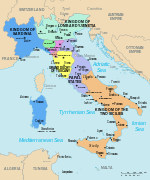Order of Saint Joseph
- View a machine-translated version of the Italian article.
- Machine translation, like DeepL or Google Translate, is a useful starting point for translations, but translators must revise errors as necessary and confirm that the translation is accurate, rather than simply copy-pasting machine-translated text into the English Wikipedia.
- Consider adding a topic to this template: there are already 3,070 articles in the main category, and specifying
|topic=will aid in categorization. - Do not translate text that appears unreliable or low-quality. If possible, verify the text with references provided in the foreign-language article.
- You must provide copyright attribution in the edit summary accompanying your translation by providing an interlanguage link to the source of your translation. A model attribution edit summary is
Content in this edit is translated from the existing Italian Wikipedia article at [[:it:Ordine di San Giuseppe]]; see its history for attribution. - You may also add the template
{{Translated|it|Ordine di San Giuseppe}}to the talk page. - For more guidance, see Wikipedia:Translation.
| Order of Saint Joseph | |
|---|---|
 Badge of the order | |
| Type | Dynastic order |
| Established | 9 March 1807 |
| Motto | UBIQUE SIMILIS |
| Founder | Ferdinand III, Grand Duke of Tuscany |
| Grand Master | Archduke Sigismund of Austria |
| Grades | Knight Grand Cross Commander Knight |
 Ribbon of the order | |

The Order of Saint Joseph was instituted on 9 March 1807 by Ferdinand III, Grand Duke of Tuscany during his reign as Grand Duke of Würzburg.[1] It was transformed into a Tuscan Roman Catholic Dynastic Order in 1817.[1]
The constitution of the Order was promulgated in March 1817, with amendments in August 1817. The order was divided into civil and military categories but these are now defunct. It is given to reward services towards Tuscan culture and civilisation and to the Grand Ducal House as a whole. [citation needed] The Order is divided into three levels:
- Knights Grand Cross, numbering thirty
- Commander, numbering sixty
- Knights, numbering one hundred and fifty
These numbers excluded Sovereigns, Heads of State, and Princes of the Grand Ducal House and other Royal Houses, Cardinals of the Holy Roman Church and Tuscan Metropolitan Archbishops. All had to be Catholics. The number of women members cannot exceed fifty, excluding Princesses of the Grand Ducal and other Royal Houses, wives of Heads of State and Dames of the Order of Saint Stephen. It is permitted for non-nobles to be admitted into the Order of the level of Grand Cross in cases of exceptional merit. Dames wear the same Cross as Knights but from a bow on the left breast. Dame Grand Crosses wear the Cross hanging from a Riband like the Knights but without the Star.
 | ||
 |  |  |
Recipients
- Grand Masters
- Commanders
- Vincenzo Antinori
- Luigi Federico Menabrea
- Knights
- Giovanni Battista Amici
- Felice Pasquale Baciocchi
- Gino Capponi
- Jean-François Champollion
- Pavel Nikolaievich Demidov
- Ibrahim Pasha
- Anatoly Nikolaievich Demidov, 1st Prince of San Donato
- Giovanni Dupré
- Alphonse de Lamartine
- Maximilian II of Bavaria
- Philipp Albrecht, Duke of Württemberg
- Bettino Ricasoli
- Federico Sclopis
- Federico Sclopis
References
- ^ a b Burke, Bernard (1858). The Book of Orders of Knighthood and Decorations of Honour of All Nations: Comprising a Historical Account of Each Order, Military, Naval, and Civil, from the Earliest to the Present Time, with Lists of the Knights and Companions of Each British Order ... Hurst and Blackett. pp. 352–353.
Bibliography
- Gregor Gatscher-Riedl, Mario Strigl, Die roten Ritter. Zwischen Medici, Habsburgern und Osmanen. Die Orden und Auszeichnungen des Großherzogtums Toskana. Vienna, Neue Welt Verlag, 2014. ISBN 978-3-9503061-5-6.
External links
- Grand Dukedom of Tuscany Dynastic Orders
- ORDER OF SAINT JOSEPH
- v
- t
- e
Sardinia

of Genoa
 Military Order of Saint George (Red-coloured cross)
Military Order of Saint George (Red-coloured cross)
Lombardy–Venetia
(Austrian orders)
 Order of the Golden Fleece
Order of the Golden Fleece Order of Saint Stephen of Hungary
Order of Saint Stephen of Hungary Military Order of Maria Theresa
Military Order of Maria Theresa Order of the Iron Crown
Order of the Iron CrownOrder of Leopold
 Order of Franz Joseph
Order of Franz Joseph Order of the Starry Cross
Order of the Starry CrossOrder of Elizabeth and Theresa
- Order of Saint Mark
- Company of the Hose
 Order of Saint George for Military Merit
Order of Saint George for Military Merit Order of Saint Louis for Civil Merit
Order of Saint Louis for Civil Merit
 Sacred Military Constantinian Order of Saint George
Sacred Military Constantinian Order of Saint George Order of Saint Louis for Civil Merit
Order of Saint Louis for Civil Merit
Modena
and Reggio
 Order of the Eagle of Este
Order of the Eagle of Este Cross of Seniority of Service
Cross of Seniority of Service
of Tuscany
 Order of Saint Stephen
Order of Saint Stephen Order of Saint Joseph
Order of Saint Joseph Order of the Civil and Military Merit
Order of the Civil and Military Merit
| Holy See | |
|---|---|
| Protected by the Holy See | |
| See also |
the Two Sicilies











































